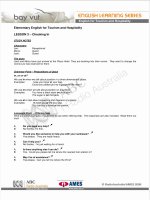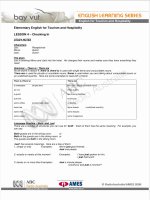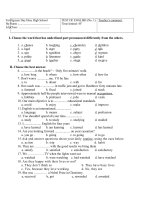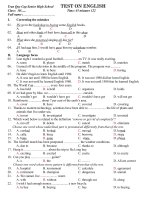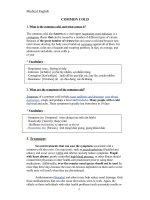ENGLISH 12-PART 3
Bạn đang xem bản rút gọn của tài liệu. Xem và tải ngay bản đầy đủ của tài liệu tại đây (2.48 MB, 49 trang )
96
Unit
9
DESERTS
A. READING
Before you
r
ead
● Work in pairs.
Ask
and answer the following questions.
1. What do you know about deserts?
2. What kinds of plants and animals live in a desert?
3. Name some of the countries which have deserts.
While you
r
ead
Read the passage and do the tasks that follow.
Three great stretches of sandy desert almost circle the centre of
Australia. To the north of Nullabor Plain stretches the Great Victoria
Desert. In the west, the Gibbon, Great Sandy, and Tanami Deserts
comprise an enormous sandy area. North of Lake Eyre lies the
Simpson Desert, the last part of Australia to be explored.
The Simpson Desert lies between Lake Eyre in the south, the
Macdonnel Ranges in the north, the Mulligan and the Diamantina
Rivers in the east, and the Macumba and Finke Rivers in the west.
The first European entered the Simpson Desert in 1845. But the desert
remained a mystery until Madigan made an aerial survey in 1929.
He named the desert after Simpson, President of the South Australian
Branch of the Royal Geographical Society of Australia.
In 1936, Colson and an Australian Aborigine took camels across the
desert. They travelled along the border of South Australia and the
Northern Territory. Three years later Madigan led a scientific
expedition across the sand dunes on a more northerly route. Colson
and Madigan both travelled eastward across the Simpson Desert.
In the Simpson Desert there are different types of dunes. In the
western part of the desert, there is a network of short dunes, mostly
less than
10 metres high. Hummock grasses grow in loose sand on the crest and
spinifex grows in the corridors between dunes and on the more stable
slopes.
In the northern part of the desert, the dunes are parallel and separated
by corridors of low, open shrubland. Spinifex grows on the slopes of
the dunes. These dunes are deep red-brown, but the sand is pale in the
area where Queensland, South Australia and Northern Territory meet.
Dry salt lakes up to 70 kilometres long and 15 kilometres wide lie
between long dunes with crests 20 metres high.
98
Task 1. Give the Vietnamese equivalents to the following words
or phrases.
1. stretch 6. dune
2. sandy 7. sloping
3. aerial survey
8. steep
4. Royal Geographical Society 9. hummock
of Australia 10. crest
5. Australian Aborigine 11. spinifex
Task 2. Decide whether the statements are true (T) or false (F).
T
F
1. According to the passage, there are three great deserts
in Australia.
2. The Simpson Desert is the largest one in Australia.
3. The desert was named after Simpson in 1929.
4. Colson and Madigan travelled across the Simpson Desert
in 1936.
5. There are more dunes in the western part of the desert.
6. Dry salt lakes are in the northern part of the desert.
Task 3. Answer the following questions.
1. What are the names of the three great stretches of sandy desert
which circle the centre of Australia?
2. Where is the Simpson Desert?
3. When did the first European enter the desert?
4. Who was Simpson?
5. How did E. A. Colson and an Australian Aborigine travel across the
desert?
6. What are the dunes like in the western and northern parts of the
desert?
7. How many kinds of grass grow in the Simpson Desert? What are
they?
After you
r
ead
Read this story and answer the questions that
follow.
At a restaurant, a Vietnamese interpreter was having dinner with an
American businessman. It was a delicious dinner and both of them
enjoyed it enormously. Before the dinner was over, the interpreter
asked the American businessman: “What would you like for your
desert?” After a pause, the American businessman answered: “Trees
and water”.
1. Is the story funny?
2. Where is the fun?
B. SPEAKING
Task 1. Work in pairs. Check the trees and animals that you think
might exist in a desert. Explain your choice.
banana
D
crocodile
D
eucalyptus
D
camel
D
cactus
D
fox
D
date palm
D
dog
D
grass
D
lizard
D
frog
D
rabbit
D
horse
D
goat
D
buffalo
D
sheep
D
Task 2. Work in pairs. Find out as many natural features of a desert
as possible. Then compare your notes with other pairs. Use the cues
below.
−
climate
−
plants/trees
−
soil
−
rainfall
−
animals
−
seasons
Task 3. Work in groups. You are going on an expedition across a
desert with some of your friends. Discuss and choose the five most
important things you should bring along with you. Explain your
choice.
−
a knife
−
a gun
−
a horse
−
food
−
a box of match
−
a car
−
a camel
−
a blanket
−
water
−
a mosquito net
−
a cell phone
−
a walkman
100
C. LISTENING
Before you
listen
● Work in pairs.
Ask
and answer the following questions.
1. What is a desert?
2. How is a desert formed?
3. Can human beings make a desert? Why/Why not?
●
Listen and
r
epeat.
frightening speed Sahara petroleum
Australia firewood Mauritania
While you
listen
Task 1. You will hear an expert talking about deserts, what they are
and how they are formed. Listen to his talk and decide whether the
statements are true (T) or false (F).
T
F
1. In a desert, everything is hard.
2. Only trees with hard needles can grow in deserts.
3. Space seems to have no limit in the desert.
4. Nature causes the change in the size and location of
the world’s deserts.
5. Rabbits are one of the agents that help make deserts
in Australia.
Task 2. Listen again and answer the following questions.
1. What central theme does the talk examine?
2. What is a desert?
3. What causes the growing of the world’s deserts?
4. In what way do rabbits contribute to the growing of deserts in
Australia?
101
Task 3. Listen to part of the expert’s talk again and fill in the missing
word(s).
In developing countries, (1) of the people use wood for
cooking and heat. They cut down trees for firewood. But trees are
important. They cool the land under them and keep the sun off
(2) . When leaves fall from a tree, they make the land
richer. When the trees are gone, the smaller plants die and the land
becomes desert.
Humans can make deserts, but humans can also (3) their
growth. Algeria planted a green wall of trees across the edge of the
Sahara to stop the desert sand from (4) . Mauritania
planted a similar wall around its (5) . Iran puts a thin
covering of petroleum on sandy areas and plant trees. Other countries
build long (6) to bring water to the desert areas.
After you
listen
Work in groups.
Summarise
the main ideas of the expert’s talk. Use
the following
suggestions:
● What is a desert?
● What causes the growth of a desert?
● What should humans do to prevent the growth of deserts?
102
General
information
Location
−
largest desert in the world
−
in northern Africa
−
extends from the Atlantic Ocean eastward past
the Red Sea to Iraq
−
lies largely in Morocco, Algeria, Tunisia, Libya,
Egypt, Mauritania, Mali, Niger and Sudan
Ar
ea
−
total area: more than 9,065,000 sq km
−
1,610 km wide and about 5,150 km long from east
to west
Natural
featur
es
−
arid land, dry climate (moisture is almost totally
absent), very hot in summer and very cold in
winter
−
few oases exist
−
sandy land and large dunes of sand
−
tableland with an average elevation from 400
to 500 m
−
few forms of animal and vegetable life
animals
acacia
−
main animals: gazelle, antelope, fox, jackal, camel
D. WRITING
THE SAHARA
DESER
T
Study the information in the table below and write a
composition
about the Sahara
Desert.
Trees
and
−
main trees: cactus, the date palm, and a form of
E.
LANGUAGE
FOCUS
●
Pronunciation:
Full and
contracted
forms of
auxiliaries
●
Grammar:
So, but, however and
therefore
Pr
onunciation
● Read the following phrases. Pay attention to how the full
and
contracted forms of the auxiliaries are
pr
onounced.
Full
forms
Contracted forms
Full
forms
Contracted forms
I am
you are
he is
she is
it is
we are
they are
I’m
you’re
he’s
she’s
it’s
we’re
they’re
I shall/will
you will
he will
she will
it will
we shall/will
they will
I’ll
you’ll
he’ll
she’ll
it’ll
we’ll
they’ll
● Practise reading these sentences.
I think I’ll buy a motorbike.
You’ll notice that there’s a girl coming.
It’ll be much better if you could do it.
We’ll have to talk to her.
She’s feeling much better now.
They’re students.
He’ll be 17 next month.
Grammar
Exercise 1. Add so or but and a comma where appropriate.
Examples:
It began to rain, so I opened my umbrella.
It began to rain, but he didn’t open his umbrella.
104
1. I didn’t have an umbrella I got wet.
2. I didn’t have an umbrella
I was wearing a raincoat.
I didn’t get wet because
3. The water was cold I didn’t go swimming.
4. The water was cold I went swimming anyway.
5. Luan’s directions to his house weren’t clear Binh
got lost.
6. The directions weren’t clear Binh found Luan’s house
anyway.
7. Her friend lied to her she still likes and trusts him.
8. Her friend lied to her she doesn’t trust him anymore.
Exercise 2. Underline the correct alternative in the following
sentences.
1. Dan didn’t study for the exam, however/but Lan did.
2. You could fly via Vienna; but/however it isn’t the only way.
3. They have lived next door to us for years,
yet/however
we hardly
ever see them.
4. My friend and I were tired, so/however we went home early.
5. We had wanted to stay until the end of the game, but/however it got
too late for us.
6. I understand your point of view.
However/Although
I don’t agree
with it.
7. The normal pulse for an adult is between 60 and 80 beats per
minute, so/but/however excitement will make a pulse much faster.
8. The food didn’t look appetizing, but/however many people started
eating.
Exercise 3. Add so, therefore or however where appropriate.
Example: It began to get dark, so I turned on the light.
I think, therefore I am.
1. He worked hard, he could earn much money.
2. The shrimp was only 2 dollars a kilo this week, I bought
three kilos.
3. He’s been studying really hard,
exams.
he can pass the
4. She is still not good at Maths. she cannot be the best
student in her class.
5. OK, you can take Chemistry as your major.
should remember that it is not easy to learn Chemistry.
you
6. The boy has chosen to do an MBA programme in Australia.
I think you should let him go.
7. It was already 6 p.m.,
went home.
we closed the office and
8. Advertisers often say that their products are the best.
the real quality is not as good as it is advertised.
106
Unit
10
ENDANGERED
SPECIES
A. READING
Before you
r
ead
Work in pairs.
Look
at the pictures and answer the questions.
1. Which of the animals and insects below can be found in Vietnam?
2. Which of them is/are in danger of becoming extinct?
a) tortoise b) rhinoceros
c) monkey d) elephant e) leopard
f) frog g) mosquito h) parrot
While you
r
ead
Read the text then do the tasks that
follow.
Endangered species are plant and animal species which are in danger
of extinction. Over 8,300 plant species and 7,200 animal species
around the globe are threatened with extinction, and many thousands
more become extinct each year before biologists can identify them.
The primary causes of species extinction are habitat destruction,
commercial exploitation and pollution. The drainage of wetlands,
cutting of forests, urbanization and road and dam construction have
destroyed or seriously damaged natural habitats. Since the 1600s,
worldwide commercial exploitation of animals for food and other
products has seriously reduced the number of rare species. Toxic
chemicals in the air and land, contaminated water and increased water
temperatures have also driven many species to the verge of extinction.
Plant and animal extinction leads to a loss of biodiversity. Maintaining
biodiversity is important for us in many ways. For example, humans
depend on species diversity to have food, clean air and water, and
fertile soil for agriculture. In addition, we benefit greatly from the
many medicines and other products that biodiversity provides.
Different conservation efforts have been made in order to save
endangered species. The Red List
−
a global list of endangered and
vulnerable animal species
−
has been introduced to raise people's
awareness of conservation needs. Governments have enacted laws to
protect wildlife from commercial trade and overhunting. A number of
wildlife habitat reserves have been established so that a wide range of
endangered species can have a chance to survive and develop.
108
Task 1. The nouns in column A all appear in the passage. Match each
of them with a suitable definition in column B.
A B
1. extinction a. the existence of a large number of different
kinds of animals and plants which make a
balanced environment
2. habitat b. the act of preventing something from being
lost, wasted, damaged or destroyed
3. biodiversity c. a situation in which a plant, an animal, a way
of life, etc. stops existing
4. conservation d. the natural environment in which a plant or
animal lives
Task 2. Choose A, B, C or D to complete the following sentences
about the reading passage.
1. The number of species around the globe threatened with extinction is
over .
A. 7,200 B. 8,300 C. 1,600 D. 15,000
2. Which of the following is NOT mentioned as a primary cause of
species extinction?
A. pollution C. habitat destruction
B. natural selection D. overexploitation
3. The Red List is a special book that provides names of
animals.
A. vulnerable and endangered C. endangered
B. hunted D. extinct
109
4. The development of wildlife habitat reserves helps .
A. save a large number of endangered species
B. make a list of endangered species
C. enact laws to protect wildlife
D. develop commercial trade and overhunting
5. The best title for the passage is .
A. Endangered Species and Conservation Measures
B. Endangered Species and their Benefits
C. The Global Extinction Crisis
D. Endangered Species Extinction: Causes and Conservation Measures
Task 3. Find evidence in the passage to support these statements.
1. Pollution is one of the main causes of species extinction.
2. Species diversity has provided humans with so many essential
things.
3. There are a number of ways to help save endangered species.
After you
r
ead
Work in pairs. Summarise the reading passage by writing ONE
sentence for each
paragraph.
B. SPEAKING
Task 1. Work in pairs. Ask and answer the following questions.
1. What do you call GÊu Tróc,
Tª Gi¸c,
Hæ, Voi in English?
2. In which sort of habitats can you find each of these animals?
3. Which of these animals can be kept as a pet or used for food or
medicine?
4. Which of them is/are endangered?
110
Task 2. Work in pairs. Look at the information about the giant panda,
tiger, rhino and elephant, which are endangered animals. Ask and
answer questions about them.
Example:
A: Where do giant pandas live?
B: In bamboo forests in the mountains in central and western
China.
A: What is the population of pandas in the
world?
B: Only about 600.
Task 3. Work in groups. Take turns to give an oral report on
111
the animals mentioned in Task 2.
112
C. LISTENING
Before you
listen
● Work in pairs. Discuss and choose the best answer A, B or
C.
1. You can find gorillas in .
A. Europe B. Asia C. Africa
2. The male gorilla may attain a
height of m and a weight of
about 180 kg.
A. 3 B. 1.7 C. 0.8
3. The life span of a gorilla in the
wild is about years.
A. 30 B. 40 C. 50
● Listen and
r
epeat.
gorilla sociable sub-adult nest
bared teeth silverback civil war forest rangers
While you
listen
Task 1. Listen to the passage and choose the best answer A, B, C or D
to each question.
1. Which of the following can be a group leader?
A. The biggest and strongest adult male gorilla.
B. A female gorilla.
C. The biggest adult female gorilla.
D. A grown-up gorilla.
2. With whom do baby gorillas sleep at night?
A. Their sisters.
B. Their mothers.
C. Their fathers.
D. Their mothers and sisters.
112
3. Why do hunters kill mountain gorillas?
A. For their skin.
B. For their nests.
C. For the trees they live in.
D. For food.
4. Which of the following statements is NOT true?
A. Mountain gorillas live in Africa.
B. Scientists study gorillas and show a different picture of mountain
gorillas.
C. Life for mountain gorillas is peaceful.
D. A gorilla sometimes eats worms.
5. What can be learned from the passage?
A. Mountain gorillas are not as dangerous as they look.
B. Mountain gorillas live in groups.
C. Mountain gorillas eat mainly plants.
D. All of A, B and C are correct.
Task 2. Listen again and complete the chart below.
General
featur
es
(1) , gentle, sociable, and
(2)
Group
members
the silverback, one or two sub-adult males,
(3)
Food
(4) and worms
Place
for
sleeping
nest (5) or (6)
Causes of
being
endanger
ed
(7) , hunters killing them for food,
(8)
113
After you
listen
Work in pairs. Summarise the main ideas of the passage, using the
information and the answers in Tasks 1 and 2.
D. WRITING
Task 1. Work in pairs. Suggest possible measures that should be
taken to solve the following problems.
● People do not know much about the need to protect rare and
endangered animals.
● Projects to save endangered animals do not have sufficient funds.
● The habitats for endangered animals are being seriously damaged
and polluted.
● People who live in or near endangered animals’ habitats have poor
living conditions and rely mostly on wildlife products for their
livelihood.
● Some countries do not have laws to protect endangered animals.
● People keep buying fashionable wildlife products.
● There are not enough wildlife habitat reserves.
Example:
People do not know much about the need to protect rare
and
endangered animals. We should organise different activities to
raise
people's awareness of the need to protect these
animals.
Task 2. Write a paragraph about measures for protecting endangered
animals using the ideas discussed in Task 1. Begin your paragraph
with:
“There are a number of measures that should be taken to
pr
otect
endangered
animals.”
114
E.
LANGUAGE
FOCUS
●
Pronunciation: Rhythm
●
Grammar:
Modal verbs: may, might, must, mustn’t,
needn’
t
Pr
onunciation
● Practise reading the following sentences, paying attention to the
stressed syllables.
1. Tell me the time.
2. Show me the way.
3. He bought some carrots and cabbages.
4. Come for a swim.
5. Look at the clock on the mantelpiece.
6. I think he wants to go tomorrow.
7. It’s not the one I want.
8. Most of them have arrived on the bus.
9. Walk down the path to the end of the canal.
10. I’m going home today for Christmas.
11. A bird in the hand is worth two in the bush.
12. If you don’t have the best, make the best of what you have.
Grammar
Exercise 1. Complete the sentences, using may/might with one of the
verbs in the box.
bite break need rain slip
wake
1. Take an umbrella with you when you go out. It might rain later.
2. Don’t make too much noise. You the baby up.
3. Be careful of that dog. It you.
115
4. I don’t think we should throw that letter away. We
it later.
5. Be careful. The footpath is very icy. You .
6. I don’t want the children to play in this room. They
something.
Exercise 2. Complete the sentences, using needn’t with one of the
verbs in the box.
ask come explain leave tell
walk
1. We’ve got plenty of time. We needn ’ t
leave yet.
2. I can manage the shopping alone. You with me.
3. We all the way home. We can get a taxi.
4. Just help yourself if you’d like something to eat. You
first.
5. We can keep this a secret between ourselves. We
anybody else.
6. I understand the situation perfectly. You
further.
Exercise 3. Complete the sentences with must, mustn’t or
needn’
t.
1. We haven’t got much time. We must hurry.
2. We’ve got plenty of time. We needn’t hurry.
3. We have enough food at home so we
today.
go shopping
4. Jim gave me a letter to post. I remember to post it.
5. Jim gave me a letter to post. I forget to post it.
6. There’s plenty of time for you to make up your mind. You
decide now.
7. You
washed.
wash those tomatoes. They’ve already been
8. This is a valuable book. You look after it carefully and
you lose it.
116
TEST YOURSELF
D
I. Listening (2.5
points)
Listen to the passage and complete the note with NO MORE THAN
THREE
words.
FACTS ABOUT THE
P
ANDA
Habitat : (0) lives in high mountains in China
Food: mainly (1)
Eating time: (2) hours a day
Number: about (3) in the wild and 100 in captivity
Cubs: more than (4) die after birth
Solution: (5)
II. Reading (2.5
points)
Read the passage and decide if the following statements are true (T),
false (F) or not mentioned (NM).
It is difficult to know how many elephants once lived in the continent,
but there may have been at least 3-5 million elephants in Africa in the
early part of the twentieth century. People have always hunted
elephants for meat, hides and ivory. As the human population grew
and weapons became more advanced, elephants were under greater
threat. In the late 1970s and early 1980s there was a huge decline in
the number of elephants due to the increase in poaching. It is
estimated that there are now about 500,000 elephants and they are
living in a small number of countries. A ban was given on all
international trade in ivory in 1989, and many governments started to
give poachers severe punishments. Thanks to such timely actions,
some elephant populations, especially those in southern Africa, have
recovered over the last decade. However, numerous threats remain
for Africa’s elephants.
117
1. There are now about 3 to 5 million elephants in Africa.
2. Elephants are hunted because they have nowhere to hide.
3. During the late 1970s and early 1980s, the number
of elephants decreased sharply.
4. Nowadays, elephants are found only in certain
countries in the world.
5. Since 1989, the trade in ivory has been prohibited
all over the world.
III.
Grammar
(2.5
points)
Complete the sentences with must, mustn’t or
needn’
t.
T F N
M
1. DOCTOR: You go on a diet; but you
eat sensibly and you overeat.
2. ZOO NOTICE: Visitors feed the animals.
3. TEACHER: You
read the whole book but
you read the first four chapters.
4. RAILWAY NOTICE: Passengers walk on the line.
5. SCHOOL NOTICE: The lifts be used in case of fire.
6. DOCTOR: You take more than two of these pills
at once. Three might be fatal.
7. DOCTOR (to patient’s wife): If the pain has gone, he
take any more of these.
IV. Writing (2.5
points)
Study the information
about the rhino then
write a
paragraph
describing the
animal
and suggest possible
solutions to protect it
from extinction.
Habitat:
Grasslands, tropical and subtropical
forests in Africa and southern Asia.
Population:
About 17,000
Height: 1.2 to 1.8 m
Weight: 1,000 to 3,000 kg
Food: Grass and plants
Life span: About 40 years
Reason for decline: Habitat destruction and
illegal hunting
118
Unit
11
BOOKS
A. READING
Before you
r
ead
Work in pairs.
Ask
each other the following questions.
1. Do you often read books?
2. What kind of books do you enjoy reading most/least?
3. How do you read books?


